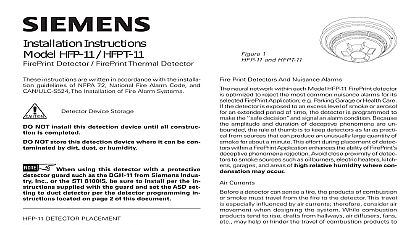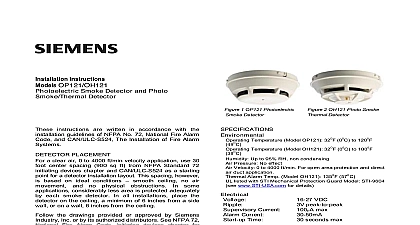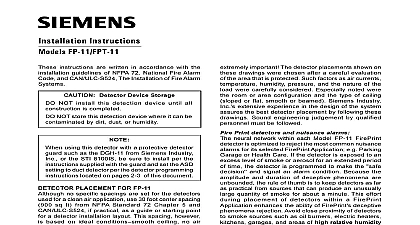Siemens SFPO-11 SFP-11 SFPT-11 FirePrint Photoelectric Detector FirePrint Detector FirePrint Thermal Detector, Installation Instructions

File Preview
Click below to download for free
Click below to download for free
File Data
| Name | siemens-sfpo-11-sfp-11-sfpt-11-fireprint-photoelectric-detector-fireprint-detector-fireprint-thermal-detector-installation-instructions-3629085471.pdf |
|---|---|
| Type | |
| Size | 774.60 KB |
| Downloads |
Text Preview
Installation Instructions SFPO 11 SFP 11 SFPT 11 Photoelectric Detector FirePrint Detector Thermal Detector instructions are written in accordance with the instal guidelines of NFPA 72 National Fire Alarm Code and The Installation of Fire Alarm Systems Device Storage NOT install this detection device until all construc is completed NOT store this detection device where it can be con by dirt dust or humidity SFPO 11 DETECTOR PLACEMENT no specific spacings are set for the detectors used a clean air application use 30 foot center spacing 900 sq ft NFPA Standard 72 and CAN ULC S524 if practical as a or starting point for a detector installation layout This however is based on ideal conditions ceil no air movement and no physical obstructions In some therefore considerably less area is protected ad by each smoke detector This is why it is mandatory closely follow the installation drawings In all installations the detector on the ceiling a minimum of 6 inches from side wall or on a wall 4 to 6 inches from the ceiling you have any questions regarding detector placement fol the drawings provided or approved by Siemens Building Inc or by its authorized distributors This is ex important The detector placements shown on these were chosen after a careful evaluation of the area is protected Such factors as air currents temperature pressure and the nature of the fire load were care considered Especially noted were the room or area con and the type of ceiling sloped or flat smooth or Siemens Building Technologies Inc extensive ex in the design of the system assures the best detec placement by following these drawings Sound engineer judgment by qualified personnel must be followed 1 and SFPT 11 2 of smoke or aerosol for an extended period of time the is programmed to make the decision and sig an alarm condition Because the amplitude and duration deceptive phenomena are unbounded the rule of thumb to keep detectors as far as practical from sources that can an unusually large quantity of smoke for about a This effort during placement of detectors within a Application enhances the ability of FirePrint decep phenomena rejection Avoid close proximity of detectors smoke sources such as oil burners electric heaters kitch garages and areas of high relative humidity where may occur Currents a detector can sense a fire the products of combustion smoke must travel from the fire to the detector This travel especially influenced by air currents therefore consider air when designing the system While combustion tend to rise drafts from hallways air diffusers fans may help or hinder the travel of combustion products to detector When positioning a detector at a particular loca give consideration to windows and doors both open closed to ventilating systems both in and out of opera and to other factors influencing air movement Do not a detector in the air stream of a room air supply dif It is better to position a detector closer to an air return distance that products of combustion or smoke travel a fire to the detector is not usually the shortest linear Combustion products or smoke usually rise to the ceil then spread out Average ceiling heights of 8 to 10 feet not abnormally affect detector response High ceilings in churches warehouses auditoriums etc do affect response and should be considered Print Detectors and Nuisance Alarms Ceiling Construction Factors neural network within each Model SFP 11 FirePrint de is optimized to reject the most common nuisance for its selected FirePrint Application e g Parking Ga or Health Care If the detector is exposed to an excess obstructions change the natural movement of air and products Depending on the direction of smoke joists and beams can slow the movement of heated air smoke while pockets between them can contain a re 315 033290C 7 Building Technologies Safety level of smoke Take obstructions created by girders beams air conditioning ducts or architectural design consideration when determining area protection Refer to Initiating Devices chapter of NFPA Standard 72 for Loca and Spacing requirements for specific types of construc e g beam suspended level sloped and peaked ceilings Indicators DETECTOR PLACEMENT Model SFPT 11 on the ceiling at least 4 inches from the walls For an ideal smooth ceiling condition place the de at a maximum center spacing of 50 feet 2500 square For FM Approved installations use maximum center of 20 feet 400 square feet Locate detectors 25 feet side walls or room partitions job conditions and sound engineering judgment must detector spacing Consider environmental factors ambient temperature fluctuation and the nature of fire hazard Room or area configuration and ceiling type or flat smooth or beamed also dictates placement questions arise regarding detector placement follow drawings provided and or approved by Siemens Building Inc or by its authorized distributors This is ex important The detector placements shown on these were chosen after a careful evaluation of the area protected Siemens Building Technologies Inc exten experience in design of the system assures the best placement by following these drawings Humidity Pressure Air Velocity operating temperature range for the SFPO 11 SFP 11 and detectors is 32 0 to 100 38 The thermal temperature is fixed at 135 57 these detec in environments where the humidity does not exceed 93 Normal changes of atmospheric pressure not affect detector sensitivity For SFPO 11 and SFP 11 open 0 1200 ft min applications use the appropriate applica from the FirePrint ASD application list Use the ASD duct for 300 4000 ft min applications a in above ceil and under floor plenums b inside an air duct and c in an duct housing using sampling tubes Follow detector spac and location requirements in NFPA 72 Chapter 5 for High Movement Areas and Control of Smoke Spread installing Model SFPO 11 and SFP 11 in existing installa with an existing duct detector housing order an AD 11UK Duct Upgrade Kit DA 304 P N 500 695967 and use it in installation This kit includes the required housing cover 305 095676 Do not use Model SFPO 11 and SFP 11 with other air duct cover air duct and open area applications the and SFP 11 smoke sensitivity range is on its nameplate Model SFPO 11 SFP 11 SFPT 11 contains an LED indi capable of flashing either one of three distinct colors yellow or red During each flash interval the micro detector checks the following For smoke in its sensing chamber That its smoke sensitivity is within the range indi on the nameplate label That its critical smoke sensing electronics are on the results of these checks the LED indicator the following PROGRAMMING detector on a loop must be programmed to respond to unique system address To program the detector address use the Model Device Programming Unit Refer to the SDPU P N 315 033260C Record the loop and device number system address the detector on the detector label and on the base to installing the detector in the wrong base The SDPU label printer can be used for this purpose bases for Model SFPO 11 SFP 11 SFPT 11 should be as shown in Figure 3 Mounting ensure proper installation of the detector head into the base sure the wires are properly dressed at installation Position all wires flat against the base Take up all slack in the outlet box Route wires away from connector terminals Building Technologies Safety 315 033290C 7 Install Detector Head CLEANING AND MAINTENANCE Align


